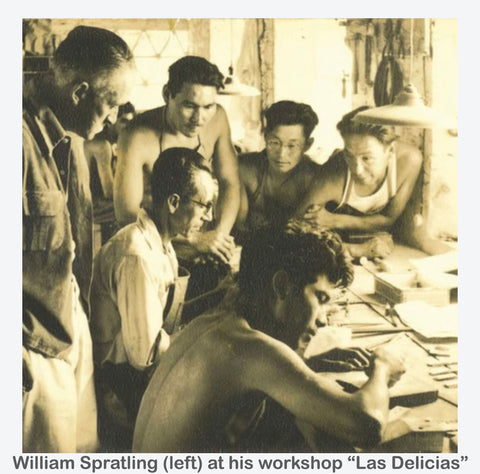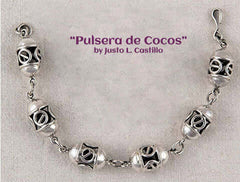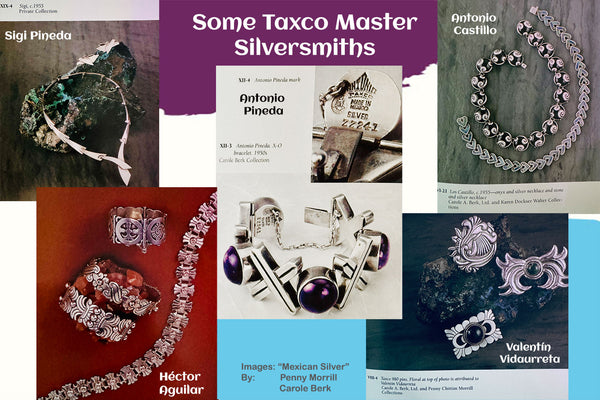
What is Taxco Mexican Silver?
A Glimpse Into the Past
The tradition of silversmithing in Mexico traces its roots back centuries, flourishing since pre-Hispanic times. Throughout history, artisans have crafted exquisite pieces using precious metals like gold, silver, quartz, opal, and amber. The abundance of these materials, coupled with the exceptional craftsmanship of artisans, has long fueled the jewelry industry in Mexico.
While Taxco was once renowned as the oldest mining center in the Americas, the extracted mineral was often shipped elsewhere for processing, rather than being utilized within Taxco itself.
However, the arrival of an American architect in the 1930s marked a significant shift in perspective and approach to doing things in Taxco. This architect's influence gave way to the famous Taxco Mexican silver, which continues to enjoy widespread recognition to this day.
The Dawn of a New Era
William Spratling, now regarded as the pioneer of Mexican silversmithing in Taxco, journeyed to Mexico with the purpose of documenting the customs and traditions of its people. As an architect, writer, designer, and member of Tulane University, he was commissioned by the US government to explore and write about the region. Enjoying close friendships with President Franklin D. Roosevelt and the US ambassador to Mexico, Dwight Morrow, Spratling found himself immersed in influential circles upon his arrival. He quickly forged connections with the prominent intellectuals of the era who frequented Taxco as a hub, including figures like David Alfaro Siqueiros, Diego Rivera, Frida Kahlo, Gerardo Murillo, and Manuel Gomez Morin, among others.
 With Spratling's arrival, Taxco transitioned from being a mere producer of silver to transforming pieces of the white metal into genuine works of art. By understanding the history of the region and appreciating the craftsmanship of local silversmiths and artisans, he solidified the silversmithing industry and initiated the contemporary movement that sparked the evolution of modern Mexican silversmithing.
With Spratling's arrival, Taxco transitioned from being a mere producer of silver to transforming pieces of the white metal into genuine works of art. By understanding the history of the region and appreciating the craftsmanship of local silversmiths and artisans, he solidified the silversmithing industry and initiated the contemporary movement that sparked the evolution of modern Mexican silversmithing.In 1931, he established the “Las Delicias” Workshop, where he mentored the initial generation of Taxqueño silversmiths and jewelers. Their enduring legacy sustains the art of silversmithing, which today serves as both an artisanal tradition and a vital economic and tourist activity, integral to the way of life in this colonial town.
“Las Delicias” was not only a workshop but a silver school as well, where Spratling collaborated with local artisans to develop inventive designs blending pre-Hispanic tradition with contemporary flair. His creations garnered worldwide acclaim, symbolizing elegance, and unparalleled craftsmanship. Employing 300 artisans organized in guilds reminiscent of medieval traditions, masters mentored apprentices, who, after years of honing their skills and mastering various techniques, advanced in rank or established their own workshops.
Pursuing Innovation and Excellence

On June 27, 1935, William Spratling initiated a contest within the "Las Delicias" Workshop to commemorate its fourth anniversary, aiming to inspire the creativity of talented young silversmiths. The inaugural winner of this "Silverwork Contest" was 20-year-old Justo Lucio Castillo Terán, who earned a diploma and a prize of $50.00 pesos for his piece titled "Pulsera de Cocos" (Coconut Bracelet), earning him the moniker "Coco Castillo." Since then, the jewelry contest has become an annual tradition, and June 27 has been designated as “Día del Platero” (Silversmith's Day), honoring the contributions of these skilled artisans.
In 1937, Antonio Pineda, a former apprentice who rose to become one of the renowned master silversmiths under William Spratling's guidance, proposed expanding this local contest to a national level, allowing silversmiths from across Mexico to participate and enhancing the recognition. Since then, every year during the last week of November, Taxco celebrates the "Feria Nacional de la Plata" (National Silver Fair) with the aim of honoring this silver trade. The first-place winner of this inaugural fair was the master craftsman Antonio Pineda.
Remarkable Talent
Sigi Pineda, Antonio Castillo, Antonio Pineda, Héctor Aguilar and Valentín Vidaurreta, all of them learned the craft of silversmithing at “Las Delicias” Workshop, becoming (among others) recognized masters of Mexican silver design. When each of Spratling’s former workers decided to go their own way, the only thing he asked them to do was to develop their own style, and so they did.

In 1939 Hector Aguilar and Antonio Castillo along with his brothers decided to leave “Las Delicias” and venture forth independently. This is how the “Borda” and “Los Castillo” workshops were inaugurated. By 1955, Spratling's initial concept had led to the establishment of three hundred silver workshops in Taxco.
Javier Ruiz Ocampo, the Chronicler of Taxco until his passing in 2022, affectionately described his hometown as "the cradle of 10,000 anonymous silversmith artists who tirelessly shape the silver metal, contributing their artistry to the revival and advancement of modern silversmithing in Mexico. They have forged their own community, and now, this vast workshop, bound only by the limits of the city, is renowned as the town of artisans with the utmost artistic sensitivity in Mexico."
Is Taxco Silver Valuable?
The value of these incredible works goes beyond the intrinsic worth of the precious metal; it includes the artistry and craftsmanship that skilled artisans put into each piece of jewelry. Taxco's craftsmanship is unrivaled, providing a standard that raises each piece to unprecedented levels of quality and beauty.
So, if you ever questioned whether Taxco Mexican silver was valuable, rest assured, its value transcends mere material worth, embodying a legacy of skill, creativity, and timeless allure.
Preparing for What Lies Ahead
Today, a new generation of designers is emerging, inspired by the legacy of the Spratling era. Many are the descendants of those who once began as "zorritas" (apprentices) in the workshops, but who, fueled by their talent and resolve, climbed the ranks to become "maestros" and establish their own workshops. Creativity and skill have been ingrained in their lineage for generations, and now, the grandchildren of those pioneers strive to uphold Taxco's sterling tradition with unwavering dedication.
Yet, the journey ahead is fraught with challenges. In a world where mass production and disposability reign supreme, the value placed on artisanal craftsmanship diminishes, impacting newer generations who no longer see the merit in preserving this noble art. Many opt to leave Taxco, seeking alternative means of livelihood rather than dedicating themselves to the craft. It is in recognition of this struggle that Nueve Sterling holds the vision of championing artisanal work, honoring the dedication of those who tirelessly strive to keep the tradition of silver craftsmanship alive.
In the video below, discover Roy Nilson's perspective, a jewelry designer whom I collaborate with for sourcing silver jewelry in Taxco. Hear his insights on Taxco's jewelry craftsmanship and the artisans behind it.
For this reason, if you, the reader, have the opportunity to invest in Taxco jewelry such as the one offered by Nueve Sterling, understand that you are not merely purchasing a product of exceptional quality and beauty. You are also contributing to the sustenance of an artisanal heritage and the economic prosperity of artisans in this quaint and remote Mexican town.
As Nueve Sterling, I remain dedicated to curating exceptional jewelry from Taxco for my website, staying true to my mission of promoting this artisanal craftsmanship in Canada and beyond.
Feel free to explore my website at nuevesterling.ca. If you have a specific piece in mind from the old Taxco era, I can bring your vision to life through my connections with artisans in the town. Feel free to contact me anytime at mariarocher@nuevesterling.ca.
Share
Why is Taxco jewelry marketed sterling AND 925 on the same piece of jewelry? I understood sterling is pure and 925 is 925/1000 pure
is there a book on mexican silver that you can recommend.?


